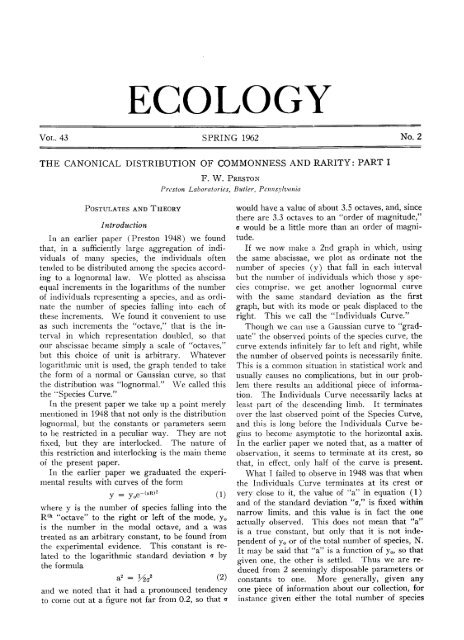The Canonical Distribution of Commonness and Rarity: Part I F. W ...
The Canonical Distribution of Commonness and Rarity: Part I F. W ...
The Canonical Distribution of Commonness and Rarity: Part I F. W ...
Create successful ePaper yourself
Turn your PDF publications into a flip-book with our unique Google optimized e-Paper software.
ECOLOGY <br />
iro~. 43 SPRIKG 1962 No. 2<br />
THE CXNONICPlL DISTRIBUTION OF COMhiONNESS AND RARITY: PART I<br />
F. Ji. PRESTOS<br />
Prc sfoli Lal~oriifi~rlis, Blrtlrr. Prrirts~ l~~riiio<br />
In an earlier paper ( Preston 1948 ) we found<br />
that, in a sufficiently large aggregation <strong>of</strong> individuals<br />
<strong>of</strong> many species, the individuals <strong>of</strong>ten<br />
tended to be distributed among the 5pecies according<br />
to a lognormal law. We plotted as abscissa<br />
equal increments in the logarithms <strong>of</strong> the number<br />
<strong>of</strong> individuals representing a species, <strong>and</strong> as orclinate<br />
the number <strong>of</strong> species falling into each <strong>of</strong><br />
these increments. We found it collvenient to use<br />
as such increments the "octave," that is the interval<br />
in which representation donbled, so that<br />
our abscissae became simply a scale <strong>of</strong> "octaves,"<br />
but this choice <strong>of</strong> unit is arbitrary. IVhatever<br />
logarithmic unit is used, the graph tended to talie<br />
the form ot a iiornlal or Gaussian curve, so that<br />
the d~str~bution was "logi~orn~al." 11-e called this<br />
the "Sprcies Curve."<br />
In the present paper we take up a point nierely<br />
nientioiied in 194s that not only is the distribution<br />
log~~ormal. but the constants or parameters seein<br />
to he restricted in a peculiar way. <strong>The</strong>y are not<br />
fixed, but they are interlocked. <strong>The</strong> nature <strong>of</strong><br />
this restriction <strong>and</strong> iriterlocking 1s the main theme<br />
<strong>of</strong> the present paper.<br />
I11 the earlier paper we graduated the experimental<br />
results with curves <strong>of</strong> the form<br />
= e-':'~"<br />
0<br />
(1)<br />
where y is the number <strong>of</strong> species falling into the<br />
Rth "octave" to the right or left <strong>of</strong> the mode, yo<br />
is the number in the modal octave, <strong>and</strong> a was<br />
treated as an arbitrary constant, to be found from<br />
the experimental evidence. This constant is related<br />
to the logarithmic st<strong>and</strong>ard deviation a by<br />
the formula<br />
a2 = Ma2 (2)<br />
<strong>and</strong> we noted that it had a pronoutlced tendency<br />
to come out at a figure not far from 0.2, so that a<br />
would have a value <strong>of</strong> about 3.5 octaves, <strong>and</strong>, since<br />
there are 3.3 octaves to an "order <strong>of</strong> magnitude,"<br />
a would be a little more than an order <strong>of</strong> magnitude.<br />
If we now make a 2nd graph in which, using<br />
the same abscissae, we plot as ordinate not the<br />
number <strong>of</strong> species (y) that fall in each interval<br />
but the nunlber <strong>of</strong> individuals which those y species<br />
comprise, we get another lognormal cnrve<br />
with the same st<strong>and</strong>ard deviation as the first<br />
graph, but with its mode or peak displaced to the<br />
right. This we call the "Individuals Curve."<br />
Though we can use a Gaussian curve to "graduate"<br />
the observed points <strong>of</strong> the species curve, the<br />
curve extends infinitely far to left <strong>and</strong> right, while<br />
the number <strong>of</strong> observed points is necessarily finite.<br />
This is a common situation in statistical worlc <strong>and</strong><br />
usuallj causes no complications, hut in our problem<br />
there results an additional piece <strong>of</strong> information.<br />
<strong>The</strong> Individuals Curve ~iecessarily lacks at<br />
least part <strong>of</strong> the descending limb. It terminates<br />
over the last observed point <strong>of</strong> the Species Curve,<br />
<strong>and</strong> this is long before the Individuals Curve begins<br />
to l~ecorne asymptotic to the horizontal axis.<br />
111 the earlier paper we noted that, as a matter <strong>of</strong><br />
obser~.ation,it seenls to terminate at its crest, so<br />
that, in effect, only half <strong>of</strong> the curve is present.<br />
\Yhat I failed to observe in 1938 was that when<br />
the Individuals Curve terminates at its crest or<br />
very close to it, the value <strong>of</strong> "a" in equation (1)<br />
<strong>and</strong> <strong>of</strong> the st<strong>and</strong>ard deviation "a," is fixed within<br />
narrow limits, <strong>and</strong> this value is in fact the one<br />
actually observed. This does not mean that "a"<br />
is a true constant, but only that it is not iudependent<br />
<strong>of</strong> y, or <strong>of</strong> the total number <strong>of</strong> species, N.<br />
It may be said that "a" is a function <strong>of</strong> yo, so that<br />
given one, the other is settled. Thus we are reduced<br />
from 2 seemingly disposable parameters or<br />
constants to one. More generally, given any<br />
one piece <strong>of</strong> information about our collection, for<br />
instance given either the total number <strong>of</strong> species

















